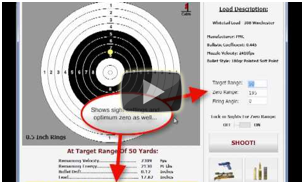Learning how to optimize your gun/load combination for maximum possible downrange performance is critical for long range shooting. This video demonstrates how to use Shoot! ballistics app/software to optimize ANY load (be it factory ammo, handloads, rimfire, muzzleloader, shotgun) for a defined target size or game animal up to 20 inches in diameter.
Watch the video below to learn how quick and easy you can optimize all your loads/guns in just a few steps…
Ballistic Terms Explained:
Target Range: The distance, in yards or meters, to the sight-in target. For example, you setup a target at your gun range 100 yards away. This is the distance to the target.
Zero Range: Zero range is defined as the range where the bullet drops back through the line of sight (LOS). If your Rifle/Load combination is zeroed at 200 yards, then this means the bullet will strike the centre of the target at 200 yards.
Sight Settings:
Tells you how high or low to set the sights (inches) at the target range, in order to zero the bullet at the given zero range.
For example:
Set sights to shoot 1.2 inches high at 100 Yards for a 220 Yard Zero.
This means you need to sight-in your gun to have the bullet impacting +1.2 inches high from the bullseye of the target at 100 yards. If you then had the same target at 220 yards, took aim at the bullseye and fired, your shot would come very close to hitting this mark (depending on how good a shot you are).
Point Blank Range:
Point Blank Range is 265 Yards.
Point Blank Range is an extremely important concept for hunters to understand. It simply means the distance at which you can hit a target without having to hold over or aim under. This depends on the vital zone of the game animal.
For example, an average sized deer has a vital zone of 6 inches. SHOOT! calculated a point blank range of 265 yards for your deer Gun/Load. What does this mean? You can be assured of a hit within the vital zone of a deer without having to compensate for holdover all the way out to 265 yards.
Firing Angle: Do you hunt or shoot in hilly or mountainous country where shots are taken downhill or uphill? You can enter any firing angle up to a maximum of 90 degrees. Remember that any angled shot, whether up hill or down hill, shoots high, so you have to hold low to compensate.
Ballistic Coefficient: Simply defined, it represents how well a bullet resists air drag. The higher the number, the better the bullet retains velocity, energy and thereby shoots flatter.

